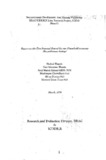Socioeconomic development and human well-being: BRAC-ICDDR,B joint research project, Matlab (phase II)
Date
1996-03Publisher
BRACAuthor
Husain, ShahedHusain, Gazi Mahmud
Ahmed, Syed Masud
Chowdhury, Mushtaque
Bhuiya, Abbas
Khan, Monirul Islam
Metadata
Show full item recordCitation
Husain, S., Mahmud Husain, G., Masud Ahmed, S., Chowdhury, M., Bhuiya, A., & Islam Khan, M. (1996, March). Socioeconomic development and human well-being: BRAC-ICDDR,B joint research project, Matlab (phase II). Research Reports (1997): Economic Studies, Vol - XII, 1–18.Abstract
This report documents the first round of the seasonal survey with respect to household economy
covering land holdings, savings and loans, employment and expenditure. For collecting household
information, the household heads were interviewed. In most cases, the heads were male members.
In the absence of male household head, other responsible member who can provide reliable
information about the household was interviewed. In the study area, a preponderance of female headed HHs (19.30%) was observed compared to the
national figure of 7 .63%. Female headship was most prevalent among TO non-member. Literacy
rate of HH heads was highest among NTO HHs followed by BRAC member HHs and TO nonmember
HHs, and these differences are significant. Agriculture and labor selling were the most
common occupation for the HH heads. NTO HHs were more likely to be involved in agriculture,
while BRAC member HHs and TO non-member HHs were most likely to be engaged in labour
selling. Contribution to HH's income was most likely in case of BRAC members who were also
HH's head as well.NTO HHs possessed the largest amount of land followed by BRAC member HHs and TO nonmember
HHs. BRAC member HHs possessed almost twice as much land as TO non-member
HHs. The percentage of landless is the highest among TG non-member HHs followed by BRAC
member HHs and NTO HHs. BRAC member HHs possess twice the amount of cultivable land
compared to TG non-member HHs. NTO HHs have the highest value of total non-land assets
followed by BRAC member HHs and TO non-member HHs.
NTO HHs have the highest amount of mean total savings followed by BRAC member HHs and
TO non-member HHs. BRAC member HHs possess nearly twice as much savings as TO nonmember
HHs . Most of the savings take place under the heading of crop savings for all HHs. NTO
HHs borrowed the highest amount followed by BRAC member HHs and TO non-member HHs.
BRAC member HHs borrowed mostly from BRAC, where TG non-member HHs and NTG HHs
borrowed mostly from relatives. Second most common source of loan was money lender for BRAC
member HHs and TO non-member HHs, but mortgages for NTG HHs. It was observed that
BRAC member HHs utilized the highest percentage of the loan for income generation followed by
NTO HHs and TO non- member HHs. Type of employment is divided into two categories: self employment and wage employment. Self
and wage employment are further disaggregated by gender. Men from all HHs spent more time in
self employment than in wage employment. Overall, men spent 43 .6 hours in employment
whereas women spent only 6.3 hours or only 14.4% of the time spent by men in employment for
previous seven days in the srudy area. Men from NTO HHs spent greater time in self employment
whereas BRAC member HHs spent greater time in wage employment.
The two major components of total expenditure are food items and non-food items. NTO HHs
expenditure on both food and non-food was the highest followed by BRAC member HHs and TO
non-member HHs. The differences among BRAC member HHs, TO non-member HHs and NTG
HHs on food expenditure were less compared to non-food expenditures. NTO HH's income from
cultivation was thrice as much as BRAC member HHs and BRAC member HHs earned nearly
double compared to TG non-member HHs.

